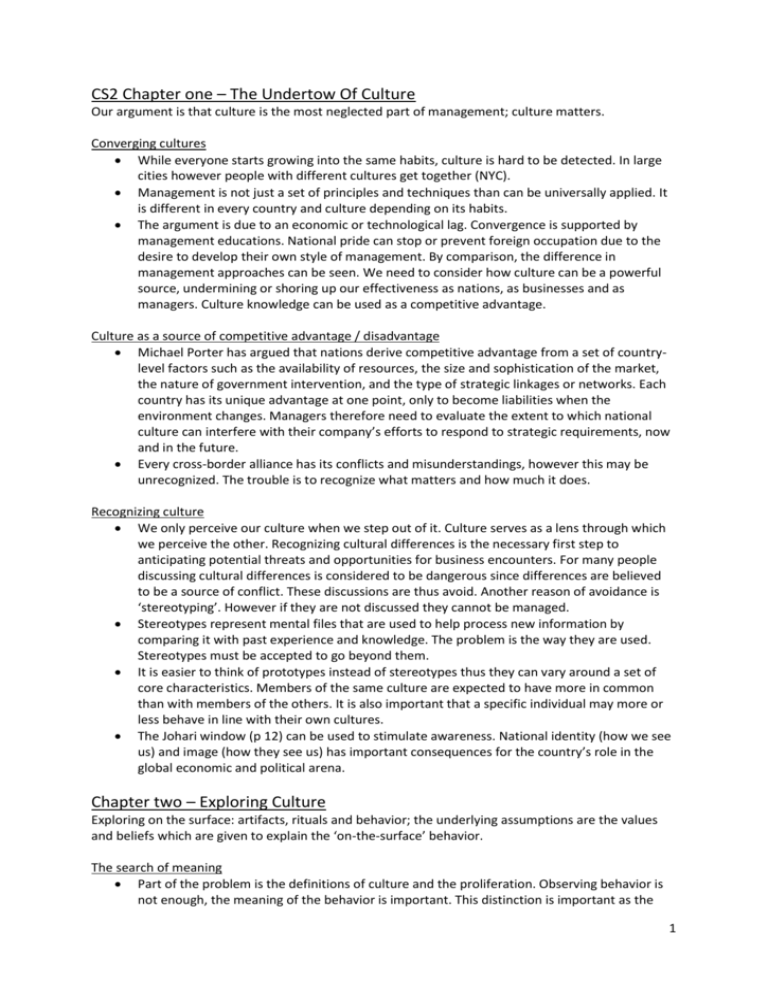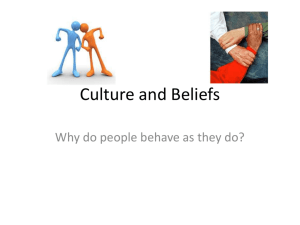CS2 Chapter one – The Undertow Of Culture
advertisement

CS2 Chapter one – The Undertow Of Culture Our argument is that culture is the most neglected part of management; culture matters. Converging cultures While everyone starts growing into the same habits, culture is hard to be detected. In large cities however people with different cultures get together (NYC). Management is not just a set of principles and techniques than can be universally applied. It is different in every country and culture depending on its habits. The argument is due to an economic or technological lag. Convergence is supported by management educations. National pride can stop or prevent foreign occupation due to the desire to develop their own style of management. By comparison, the difference in management approaches can be seen. We need to consider how culture can be a powerful source, undermining or shoring up our effectiveness as nations, as businesses and as managers. Culture knowledge can be used as a competitive advantage. Culture as a source of competitive advantage / disadvantage Michael Porter has argued that nations derive competitive advantage from a set of countrylevel factors such as the availability of resources, the size and sophistication of the market, the nature of government intervention, and the type of strategic linkages or networks. Each country has its unique advantage at one point, only to become liabilities when the environment changes. Managers therefore need to evaluate the extent to which national culture can interfere with their company’s efforts to respond to strategic requirements, now and in the future. Every cross-border alliance has its conflicts and misunderstandings, however this may be unrecognized. The trouble is to recognize what matters and how much it does. Recognizing culture We only perceive our culture when we step out of it. Culture serves as a lens through which we perceive the other. Recognizing cultural differences is the necessary first step to anticipating potential threats and opportunities for business encounters. For many people discussing cultural differences is considered to be dangerous since differences are believed to be a source of conflict. These discussions are thus avoid. Another reason of avoidance is ‘stereotyping’. However if they are not discussed they cannot be managed. Stereotypes represent mental files that are used to help process new information by comparing it with past experience and knowledge. The problem is the way they are used. Stereotypes must be accepted to go beyond them. It is easier to think of prototypes instead of stereotypes thus they can vary around a set of core characteristics. Members of the same culture are expected to have more in common than with members of the others. It is also important that a specific individual may more or less behave in line with their own cultures. The Johari window (p 12) can be used to stimulate awareness. National identity (how we see us) and image (how they see us) has important consequences for the country’s role in the global economic and political arena. Chapter two – Exploring Culture Exploring on the surface: artifacts, rituals and behavior; the underlying assumptions are the values and beliefs which are given to explain the ‘on-the-surface’ behavior. The search of meaning Part of the problem is the definitions of culture and the proliferation. Observing behavior is not enough, the meaning of the behavior is important. This distinction is important as the 1 same behavior can have different meanings and different behaviors can have the same meaning. There is a difference between espoused theory (what people say) and theory in use (what people mean). These are difficult for outsiders to detect. Universal: etic, group: emic. Interpretive approach: the search for meaning calls for an interpretive approach. This approach involves extensive observation and interviewing to provide detailed descriptions. So-called grounded theories are developed via patterns and themes that emerge. For the interpretive approach a case must be build and it is possible to live the life of the researched to gain more native information. When interpretation hits closer to home, and plans for action can then be formulated together. This is sometimes referred to as action or clinical research. To discover the meaning of culture an action-based approach is necessary. The framework given serves to integrate different definitions of culture as well as to provide tools for discovering culture. It organizes meanings of culture as behavior, artifact, values and beliefs, as systems of meaning and as ways of knowing, going from the most accessible to that which can only be inferred. Architecture and design Architecture and design hint at the underlying assumptions regarding internal integration. Greeting rituals are not to be overlooked by their importance. Formality is expressed by greeting with their last names, the formal version of ‘you’ and titles. Making contact, dress codes, written versus verbal contracts are important. Beliefs and values There are different criteria for success and they differ in who is the most important: the customers, the employees or the stakeholders? But what is management exactly? A popular job-orientated and pragmatic definition is ‘getting things done through other people’. A people-orientated definition is ‘developing people through work’. Beliefs about who is the right manager, what is management and what constitutes success are ultimately linked to values which indicate what is considered to be important, and thus deserving of attention. Basic assumptions The assumption of control over nature versus fatalism is connected to the desirability of taking action. When managers assume they are in control over nature, they are more likely to take action. How truth is determined varies between cultures. Some may use astrologists and fortunetellers. Assumptions regarding human nature relate to nature of relationships. Universalism versus particularism; in universalism rules and regulations apply to everybody, not just to your enemies. In particularism this is otherwise. Hofstede’s masculinity versus femininity is taking care of the business versus taking care of the people. Assumptions regarding space, language, and time relate to both issues of external adaptation and internal adaptation. Space can be expressed in physical and personal. Hall makes the distinction between high-context (communication depends on the person and the situation) and low-context cultures (communication is direct and clear). This can even cause difficulties in the same mother tongue. When different attitudes towards time are easy to detect, the underlying meaning is difficult to appreciate, this is by Hall described as monochromic (time spent as money is spend due to limited time) versus polychromic (unlimited time). 2 Interpreting patterns of culture There are three dimensions: o Linear active, more task-orientated. o Multiactive, relationship-orientated. o Reactive, value harmony and adapting and are sensitive to the needs and concerns of others. Above can be related to the blue-green table of Andre Laurent on page 48. Chapter four – Culture and Organization Different schools, different cultures Structure is determined by organizational features such as size and technology. Centralized and formal: mechanistic. Decentralized and informal: organic approach. Societal context creates differences in structure in different countries: emic. Institutional arrangements are not irrelevant in comparison with cultural reasons. Culture and structure Hofstede identified four value dimensions on which countries differed: 1. Power distance; the extent to which a society accepts the unequal distribution of power in institutions or organizations. 2. Uncertainty avoidance; a society’s discomfort with uncertainty, preferring predictability and stability. Individualism / collectivism; the extent to which people prefer to take care of themselves and their immediate families, remaining emotionally independent from groups. 3. Masculinity / femininity; reveals the bias towards either masculine values of assertiveness, competitiveness and materialism towards feminine values of nurturing, and the quality of life and relationships In countries with high uncertainty avoidance organizations would tend to have more formalization evident. Technical competence would be more important in defining jobs and functions. In countries with high collectivist orientation there would be a preference as opposed to individual decisionmaking. In countries with high ranked masculinity the management style is likely to be more concerned with task accomplishment than nurturing social relationships. Having ranked countries on each dimension, Hofstede then positioned them along two dimensions at a time, creating a series of cultural maps. This shows that countries that are higher ranked on power distance and uncertainty avoidance would be expected to be more mechanistic (bureaucratic). The opposite countries are more organic. According to André Laurent the underlying cultural assumptions are expressed in beliefs regarding the need for hierarchy, for formal rules and procedures, specialized jobs and functions. These beliefs and values, in turn, are observable in behavior and artifacts. André Laurent argues that country differences in structure reflect different conceptions. Those who view the organization as a political system consider managers to play an important political role in the society and to negotiate within the organization. When organizations are viewed as systems of role formalization managers prefer detailed job descriptions. Laurent concluded that managers had different conceptions of organization: o Focused on the task: instrumental. o Focused on relationships: social. According to self-reports clear differences and similarities emerge in terms of the nature of relationships (hierarchy) and the relationship with nature (uncertainty and control). 3 Culture and processes Ascription versus achievement: whether you are valued for who you are versus what you do. What kind of information is sought, how information circulates and what information is shared with whom, are likely to reflect cultural preferences for hierarchy, formalization and participation. Decision-making requires seeking consensus. Differences in approaching this can be attributed to multiple, interacting dimensions. Chapter five – Culture and Strategy Karl Weick recognized that culture and strategy are closely related. The cultural roots of strategy Greek soldiers were trained to analyze organizational strengths, weaknesses, and environmental opportunities and threats (SWOT) in order to create the perfect strategic alignment. The rational analytic approach takes for granted certain assumptions. Another approach is that strategy is a dynamic process within highlighted the emotions and feelings. The Japanese strongly belief that peripheral vision is essential to discerning changes in the customer. Strategy is considered emergent or evolutionary rather than planned. The newest strategies reflect underlying assumptions by placing the emphasis on what the company is versus what it does. Cultural models of strategy Cultural assumptions regarding external adaptation are particularly relevant to strategy as its purpose is to align the organization with its environment. Thus assumptions having to do with the relationship with nature (control), human beings (as capable), the nature of truth and reality (facts and figures, logic) and the nature of relationships (the role of hierarchy and the collective) influence the sources and the type of information sought, and the methods of interpreting that information. Different assumptions lead to different models of strategic management which can be categorized as controlling versus adapting. The controlling model can be characterized as centralized and formalized. The environment can be controlled and the decisions are made by important managers. (defender) The adapting model is more decentralized and informal. Scanning is broader based (peripheral vision) and less systematic. The environment cannot readily be known or controlled. (prospector) Strategic process: controlling versus adaptation. Strategic profile: defender versus prospector. Strategic content: cost-cutting, efficiency, rationalization, market expension, etc. Interaction effects The national context or institutional environment includes the role of government and unions, the market conditions, economic and political systems, educational systems and history. They play an important role in determining strategy. Appendix: internationalization – the role of national culture The notion of cultural distance, the greater the difference the greater the potential difficulties. High context vs. low context: information is embedded and not made explicit; obtaining information relies on personal connections. Relationships vs. tasks: doing business with friends is more important than getting the best deal. According to Shenkar there are several questionable illusions: o The illusion of symmetry; the cultural distance is the same for both countries. o The illusion of stability; no convergence over time or no potential learning curve. 4 o o o The illusion of linearity; there may be a lag of time for performance effects as cultural distance may play a different role in strategic choice versus operational phases. The illusion of causality; factors other than culture may create distance. The illusion of discordance; some factors, cultural or organizational, may be more important than others. Chapter seven – The International Manager The international manager was synonymous with the expatriate manager. But companies were constantly searching for a better executive which led to global managers or the Euromanager. International manager also means international elite of executives who fly constantly etc. This doesn’t enhance the ability to think internationally. Due to technological advances you can be an international manager who never leaves the house. Companies need to focus less on who is an international manager and consider what international tasks and responsibilities employees really fulfill. Lessons from abroad The process of adjusting to a new cultural has a u-curve with three phases: an initial stage of elation and optimism period of irritability, frustration and confusion gradual adjustment to the new environment. The frustration is also known as culture shock. The culture shock does show that the manager is infiltrating in the new culture, it also provides motivation. There are also dilemmas involved: how much of your work-way is good and how much do you have to adapt? Competencies for managing internationally Interpersonal skills are crucial: integrating socially. Time pressure and a strong task orientation can interfere this. Some experts say you have to be low-task oriented and more people oriented. Speaking the language is crucial. Motivation to live and work abroad is crucial as well. More crucial competencies: patience and respect, cultural empathy, strong sense of self and sense of humor. Understand interdependencies; respond to different cultures simultaneously; recognize cultural differences at home, don’t expect they will adapt when they get here; be willing to share power; demonstrate cognitive complexity: the ability to think along multiple dimensions while seeing the ways that these dimensions are interrelated. Also a ‘culturalgeneral’ approach needs to be developed. This shows the importance of parts of a culture. Finally you need to rapidly learn and unlearn about others culture. A global mindset can be described in terms of cognitive (waarnemings) structures and processes. These need to be well differentiated, to comprehend differences while at the same time be well integrated to find similarities. Cosmopolitanism: finding commonalities across places – Rosabeth Moss Kanter. Cognitive processes refer to the way information is gathered and interpreted. Developing cultural competencies Due to individual backgrounds you might take cultural differences for granted. Abroad experiences make you a more interesting person. A problem is that many don’t want to move abroad. 5 Personal strategies for managing across cultures ‘When in Rome, do as the Romans do’ is not applicable anymore, because cross culture contacts take place in other countries or virtual. A strategy is when others are more familiar with your culture than you are with theirs, do it your way. Another possibility is to embrace the other culture’s way of doing things. I may simply not be possible to behave as the other or to expect them to behave as you would. What is appropriate is determined by the relationship. Receptiveness to others cultures does not mean losing one’s own values. A strong selfidentity is needed to be a cross cultural manager. The challenge is to have the willingness to confront our own assumptions, to question them, and to hold on to the essential ones out of a sense of conviction rather than fear for something different. Chapter eight - The ‘multicultural’ team Multicultural teams come up with the best ideas and make the best decisions because of a greater range of perspective and options. Multiculti-teams are put together, they don’t just happen. Why multicultural teams? Boundaries within a company and outside a company become more and more multicultural. These teams can contribute to what Paul Evans refers to as the organization’s ‘glue technology’: encouraging cohesiveness among otherwise independent, autonomous national subsidiaries and other business and functional units. Transnational teams also create lateral networks which can improve communication and information flow between subsidiaries and HQ and among subsidiaries (dochterondernemingen). Task strategies The most important element of a successful team is having a ‘shared sense of purpose’. But this is not an easy task. It does not just mean agreeing on what the group is expected to accomplish overall, but also ‘setting specific performance goals and objectives’. Setting the agenda is one area where cultural differences can be a source of potential confusion and friction. Another important cultural difference in setting agendas is high and low-context; the degree to which things are spelled out versus inferred (afgeleid). Assigning roles and responsibilities within the team. In more collectivist cultures assigning individual tasks seems rather strange. They expect to work in a group and do everything together. In cultures where hierarchy is important someone is expected to lead a discussion and to have the final word in decisions. There are different ways of looking at consensus. It is time consuming and does not guarantee the best decision. The best decisions are achieved after active debate. Process strategies A first thing to agree on is the working language. A low-context approach may be necessary for the group leader to make sure everyone understands the questions during a meeting. Patterns of language also differ, for instance when to silence. On technology must be decided which to use and when. For teams to function effectively they need to establish mechanisms or ways to resolving conflict. Avoiding rather than confronting conflict may preserve team harmony and the leader’s authority. Reweaving differences: Joseph’s coat Multiculti-teams must be willing to identify, and negotiate differences in expectations regarding the task strategies and the processes of interaction. 6 Appendix, virtual teams Some argue that virtual teams need to meet face to face to develop trust. This is a key ingredient for cross cultural teams. Chapter nine - The ‘global’ organization There are three basic organizational strategies for managing cultural differences: ignore, minimize or utilize. Relationship between HQ (headquarters) and subsidiaries: o Ethnocentric: all policies and procedures come from the top. o Polycentric: how policies and procedures are implemented is determined locally (HQ decides what, locals decide how). o Regiocentric: regional HQ serves as a buffer, negotiating between home country HQ and host country subsidiaries in a particular region. o Geocentric: policies and procedures, the whats and the hows, are developed with input of both HQ and subsidiaries, as well as across subsidiaries. Ignoring cultural differences: business is business By ignoring cultural differences you are saying business is business and everyone is the same. For these companies, policies and practices developed in the home country are considered to be readily transferable. And host country subsidiaries are expected to apply them to the letter. This, they argue, is necessary in order to maintain product quality, to uphold customer service and technological standards and ensure that the corporate culture is shared by all employees. They want universalism. Minimizing cultural differences This approach recognizes cultural differences as important, but mainly as source of problems or threats to efficient and effective operations. These companies assume that a strong corporate culture can be created to serve as a melting pot to reduce the impact of different national cultures. However, it is difficult to implement standardized systems and procedures or to create a global corporate culture that does not reflect the head-office national practices and culture, and thus may resemble an ethnocentric approach. For this reason it is often resisted. Cultural transfer agent: official bearer and custodian (bewaarder) of the head-office. A mother-daughter company is built on trust. They often visit each other. Isolating is another way of minimizing the impact of cultures. This reflects the polycentric approach; each local company has the authority to make decisions. Regional headquarters (regiocentric approach) to improve coordination between national organizations and to seek out potential synergies between them. They are often set up as a step towards geocentric approach. Utilizing differences: going global? Local resistance is high formerly powerful country heads see their power and autonomy being diminished. Finding the proper balance between responsiveness to local needs and central control is an ongoing dilemma for most multinational companies today. Competitive advantage is a matter of creating assets across borders. Local managers must seek to develop local insights which have potentially universal appeal. Less global than we thought The real test of a global company is the extent to which strategic thinking actually benefits from cultural diversity. 7 Creating culturally strategic alliances Given the competing interests of nationalism and globalism, companies may operate more like political federations, in which each company retains local ownership and governance but seeks alliance to accomplish difficult or expensive missions. Gaining competitive advantage from cultural differences A truly multicultural organization can be defined as one wherein diversity is valued and utilized rather than just contained. The strategy of utilizing cultural differences can create competitive advantage. The challenge is to discover solutions that capture the differences in creative ways so that the sum of the pats is greater than the whole. To find ways to capitalize on differences, to utilize cultural differences in order to gain competitive advantage, differences have to be acknowledged and accepted as legitimate. 8







